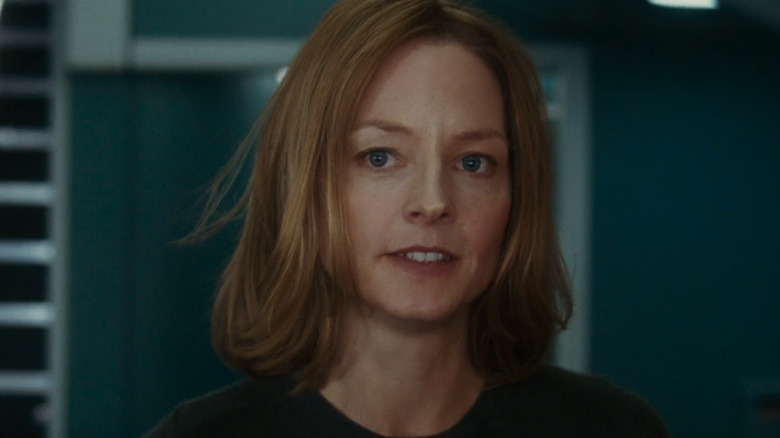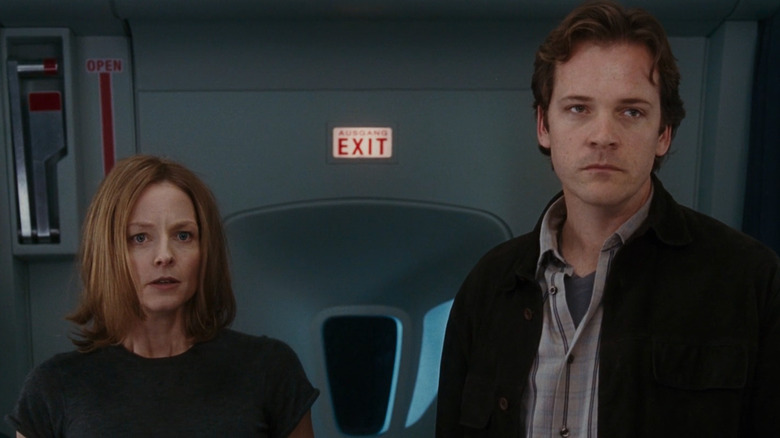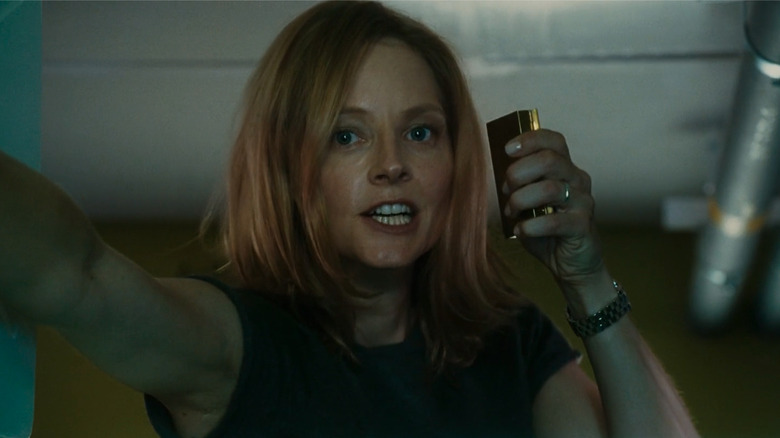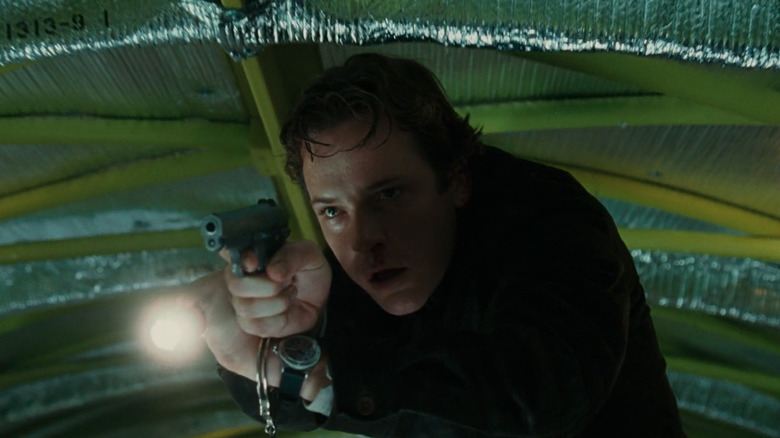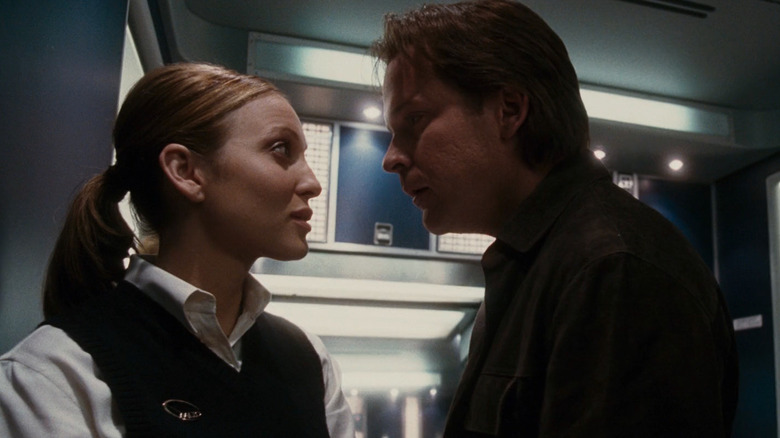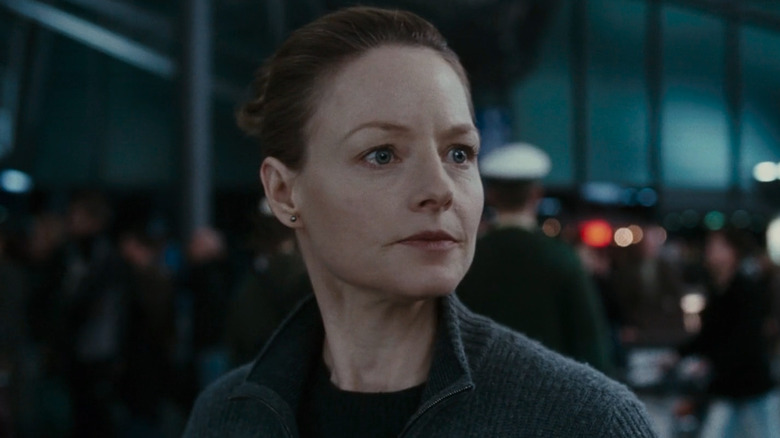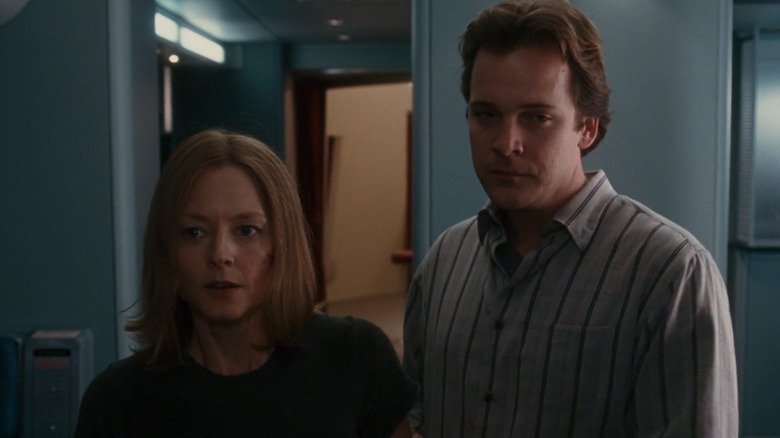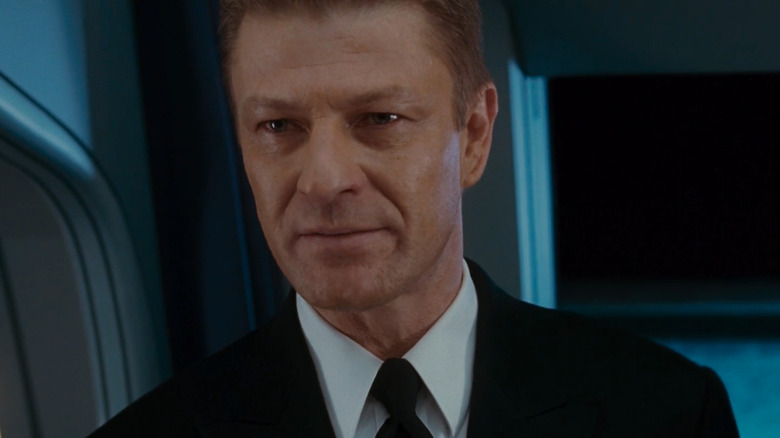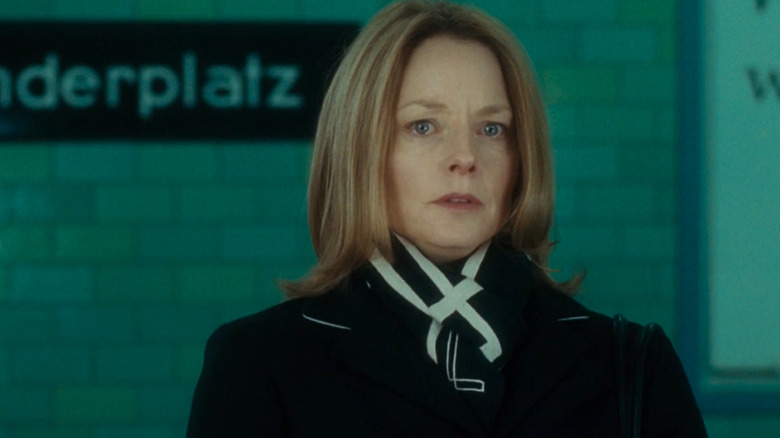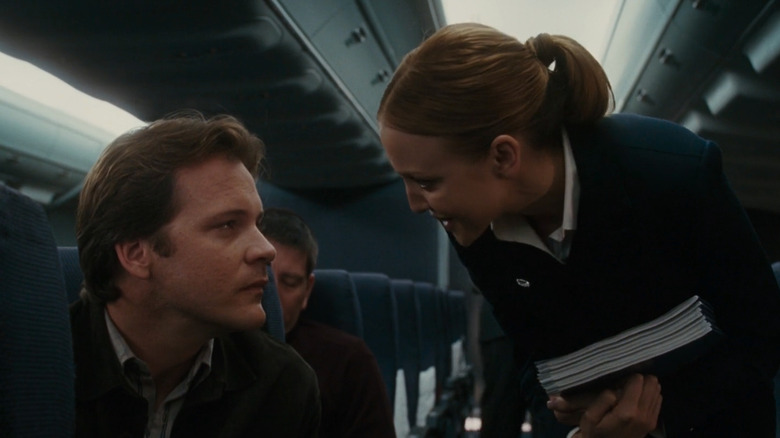The Ending Of Flightplan Explained
The 2005 psychological action thriller "Flightplan" stars Academy Award winner Jodie Foster as Kyle Pratt, who suffers every parent's nightmare when she loses track of her daughter. The bigger problem, though, is that they're trapped aboard an international flight from Berlin to the United States, and there are only so many places her daughter could have gone.
Pratt's ordeal takes an even more sinister turn when newly discovered evidence suggests that her daughter may be little more than a figment of her imagination, and she's suddenly faced with the possibility of losing her grip on reality. Is it possible that Julia (Marlene Lawston) doesn't actually exist? Or is there an intricate deception going on, a complex plot being carried about by some unknown agent aboard the plane conspiring to kidnap her daughter for a nefarious purpose? These are the questions that Pratt must face, and the audience must attempt to unravel as the flight heads to its destination.
During the course of the film, it seems like an enemy could be around any corner. Could it be a scheme by international terrorists or a conniving captain, or is the flight's designated sky marshal know more than he's letting on? In a stunning final act, all the answers are revealed. And we're here to get to the bottom of it all, from a nerve-wracking chase through the bowels of the plane to the film's many spine-tingling twists. Stow away your tray tables and put your seat in an upright position, because this is the ending of "Flightplan" explained.
What you need to know about Flightplan
When "Flightplan" begins, Kyle Pratt — an airline engineer (and designer of the Elgin E-474 double-decker passenger jet) is in Germany, identifying the body of her husband David (John Benjamin Hickey), who recently died after a fall. Kyle is having visions of her husband and is understandably distraught, but must collect her young daughter Julia for the trip back to the United States. With her husband's body in a casket secured with a digital passcode, they board an Elgin E-474 and depart for home.
Not long after takeoff, however, Kyle loses sight of Julia aboard the plane when she falls asleep after taking anxiety medication. Captain Rich (Sean Bean) reluctantly orders a search of the jet from nose to tail but turns up nothing. Kyle is even more disturbed, however, when she learns that nobody aboard seems to even remember that her daughter existed, and Julia's name is not on the plane's manifest. Then, when records back in Berlin say that Julia died along with David, Kyle must face the possibility that she's suffering from hallucinations.
But Kyle's discovery of her daughter's presence — in the form of a heart she'd drawn on the plane's window — sends her on a desperate fight to prove her daughter has been kidnapped. Knowing the ins and outs of the plane's design, she must elude the crew, including sky marshal Gene Carson (Peter Saarsgard), to find Julia and discover who is responsible for her daughter's disappearance before it's too late.
What happened at the end of Flightplan?
Throughout "Flightplan," Kyle is presented with overwhelming proof that she's been suffering from tragedy-induced hallucinations: She's told that her daughter is dead, and the lead flight attendant even insists that Julia never boarded with her. Meanwhile, Carson the sky marshal — sympathizing with her plight – enlists the aid of a therapist among the passengers to help her understand that what's happening may all be in her mind. But Kyle is unwilling to shake the feeling that something may have happened to Julia aboard the plane, and she rushes to find her daughter, who she believes has been kidnapped by an unknown enemy.
Sneaking into the plane's hold, Kyle unlocks her husband's casket, thinking Julia may be hidden inside, but finds only David's lifeless body. But because she's gone rogue, Captain Rich believes Kyle is now a danger to the flight, and has the flight diverted to Newfoundland, where they will have her arrested. It's then that Rich is informed that Kyle is not what she appears, and is told that she's actually a terrorist holding the flight hostage for a large ransom, and has been using her daughter's apparent disappearance as a ruse.
Kyle realizes that she's being framed as a hijacker when the plane lands in Newfoundland. Knowing her daughter is still hidden aboard the plane, and deducing the mastermind of the entire plot, Kyle thinks on her feet to turn the tables on the real villain.
Who is the real villain in Flightplan?
Perhaps trying to recapture the eerieness of movies like "The Sixth Sense" or "Fight Club," the realization that Julia may only be a figment of Kyle's imagination casts a pall over much of the film. Could Kyle be losing her sanity, and inventing the entire scenario to cope with the death of her husband and child? The reality, however, is that Julia did indeed board the plane, and was kidnapped as part of an elaborate plot to ransom the flight for $50 million dollars. And it was Carson — the flight's designated sky marshal — who was behind the entire affair, and he's told Captain Rich that she's the real hijacker in an effort to get away with his crime.
In a shocking final twist, though, we learn that Carson isn't just a fiendish arch-criminal, he's also a murderer: He was responsible for the death of Kyle's husband David, who he'd killed to ensure a secured casket would be aboard the flight. Only with the casket aboard would he have had a means of smuggling the necessary explosives aboard the plane undetected. Julia's kidnapping was the second phase of his plan.
Sedating the six-year-old, he planned to keep little Julia hidden away, using her disappearance to drive Kyle to search the hold and enter her secret password to unlock the casket. This would give him access to the explosives which he'd set around the plane to threaten its destruction while framing Kyle for the whole thing.
Who was involved in the plot and what happened to them?
Gene Carson is the mastermind behind the plot to hijack the flight out of Berlin, and he kidnaps little Julia to set his plan in motion. But he doesn't do it alone, and actually has other accomplices working behind the scenes, though it's not immediately clear who they are and what part they played. Though some may have suspected Captain Rich given his nasty attitude, it's actually Stephanie (Kate Beahan), the lead flight attendant, who is his primary accomplice. Though not said directly, it was likely Stephanie who altered the flight's manifest and deleted Julia's name, and it was her word about not seeing Julia with her during boarding that helps sway others into believing that the child was never there.
In addition, the film's final scenes reveal that a mortuary worker in Berlin has been arrested as a part of the scheme. It was this third accomplice who was responsible for falsifying the records of Julia's death. Stephanie is arrested by the FBI in Newfoundland. But when it comes to Carson, it's up to Kyle to take him down.
Upon their landing, she realizes she's being set up. In an attempt to save lives and catch Carson, she plays along with his plan, poses as the real terrorist, and orders everyone off the plane except for the two of them. Knowing the inside of the plane inside and out, she's able to rescue her daughter from the secret avionics compartment and lock Carson inside where she detonates the explosives, killing him in a massive fireball.
What was the Flightplan really about?
"Flightplan" can easily be seen for what it appears to be on the surface: A psychological thriller and suspenseful action movie about a woman determined to stop a villain who has kidnapped her daughter. The question of whether the fiendish plot is real or imagined makes it a mind-bender, too, but there is much more going on beneath the surface that audiences may not have even realized.
At its core, "Flightplan" is about dealing with a life-changing event. The story of Kyle, who is shaken by the loss of her husband so profoundly that she struggles to maintain her sanity, explores what it takes to re-awaken from tragedy. Brought back to reality thanks to the disappearance of her daughter, "Flightplan" examines "the fragility of existence" and how helpless it can feel to not be in control, said director Robert Schwentke in a 2005 interview with Phase 9.
"I had cancer when I was 27 and I was misdiagnosed and so by the time they caught it, it was a bit of a problem and I spent a lot of time in the hospital. And since then I just sort of think you're not in control. You may think you're in control but you're really not." Schwentke had already made a film about his experience, the German comedy "Eierdeibe," but "Flightplan" allowed him to deal with the more serious side. "The movie starts with somebody who has just experienced a tremendous tragedy ... And she has to really rebuild her psyche, and rebuild her world."
What has the cast and crew said about the ending of Flightplan?
Director Robert Schwentke isn't the only one to discuss the ending of "Flightplan." Star Jodie Foster also opened up about her character Kyle's evolving story in the film, and where she winds up when it's all said and done. Describing the film as "a personal journey," she said it's "a glimpse at how one woman reacts under the greatest sort of stress and panic," during an interview with noted film critic Emmanuel Levy. "Kyle isn't really so much heroic as she is absolutely driven. She might sometimes be brash, sometimes irrational, other times manipulative. But she will do anything she can to find her daughter."
By contrast, Foster's co-star Peter Saarsgard talked about the difficulties in shooting the film's ending, particularly a moment when Kyle forces the plane into a crash-landing procedure. "The gas masks coming down" was the toughest part for him, according to his own chat with Phase 9. "And there were so many extras and when the masks come down all hell is breaking loose." Still, the stress he felt filming that sequence, he admitted, was nothing compared to what all the extras had to deal with. "I give a lot of credit to those extras because they sat in the same seats for three months and we're not allowed to leave the plane — and yes they were in coach!"
How the end of Flightplan divided fans and critics
When "Flightplan" was released to theaters in 2005, it was met with decidedly mixed reviews from critics and fans. On review aggregator Rotten Tomatoes, it sits at just 37% among the pros, though audiences were more favorable. It seems the ending of the film, and especially its multiple twists, is one big reason why it divided opinions. Those who disliked it, like Empire Magazine, weren't won over, knocking it for plenty of plot holes and a final act that lacks "the big suckerpunch or storytelling grace to deliver a satisfying resolution." That said, it received plenty of positive reviews, too.
Both Roger Ebert and the Observer gave the film good reviews, with the latter calling it an "effective thriller." Ebert meanwhile awarded it an impressive three-and-a-half stars while praising the film's many twists and ability to keep the audience guessing. In fact, he outright refused to discuss the plot beyond its opening set-up because he apparently felt the ending was so successful that he didn't want to spoil it for viewers. "If someone tries to tell you anything else about 'Flightplan,' walk away."
Still, even some who liked the movie weren't wholly satisfied with the ending. "There are a few too many turns towards the end, and the climax errs towards anti-climatic," said Joshua Starnes of ComingSoon.net, while still recommending the film and giving it a pretty solid 7 out of 10 rating.
How casting subverted the audience's expectations
Throughout "Flightplan," the audience is constantly kept wondering what's really going on, with new information that makes one rethink everything. From the discovery that Julia's name isn't on the manifest, to a call with officials in Berlin that reveals Kyle's daughter actually died in an accident, nothing is as it seems. Repeatedly, viewers are forced to question everyone in the movie and wonder what their motives might be, and as it turns out, the film used its casting to help ratchet up the suspense, as explained in a behind-the-scenes featurette.
Executive producer Robert Dinozzi said that they wanted to keep audiences guessing about eventual villain Gene Carson, and cast Peter Saarsgard. A lesser-known actor at the time, a decade before he played the sinister Bogue in the remake of "The Magnificent Seven," his biggest roles at that point were playing soft-spoken types. "Not being able to identify Peter [Saarsgard] as the villain until very late in the movie allows us to also perhaps aim the audience's attention at characters like [Captain Rich]," Dinozzi said.
To throw off the audience further, the film intentionally chose Sean Bean, known for playing villains, in the role of Rich, who they knew audiences would immediately suspect as being the baddie. "I've seen a lot of movies with Sean [Bean] and he seems to be typecast for a very specific type of role," Dinozzi said, perhaps alluding to his villainous parts in movies like "Patriot Games," "GoldenEye," and the previous year's "National Treasure."
How the story of Flightplan changed during development
The climax of "Flightplan" almost turned out very differently than what we got on screen. According to director Robert Schwetke, he completely overhauled the original script, which initially featured a totally different kind of protagonist. "The movie was actually written for a man," he an interview with MTV. As the director described, the male hero struggled to connect with his daughter, who he rarely sees, before her disappearance. "Then we had the idea ... maybe we need to do this with a mother."
The terrorist attacks on 9/11 also forced a major shift in the story. While the finished film does capture the paranoia of post-9/11 air travel, particularly in a subplot related to a pair of Middle Eastern passengers who are wrongly accused of abducting Kyle's daughter, the original version of the film was more overtly a story of an in-flight hijacking. "It had been written prior to 9/11 and it dealt with terrorists on board of a commercial airliner en route to New York," Schwentke told Phase 9. One draft would have seen an airport security officer lose track of his son, and fight to take down a fiendish terrorist plot in mid-air.
"Post-9/11 there's not a lot of pleasure in that," Schwentke acknowledged. "I just felt that we could put the emphasis on whether the girl, Jodie's character's daughter, exists or not, and make that the dramatic engine of the movie."
How the ending of Flighplan caused a real-life controversy
There are loads of thrilling moments and even some heart-stopping action in "Flightplan," from the tension of a missing child to the explosive finale. Yet there was one other bit of excitement surrounding the film beyond the cheers from fans singing its praises. There was a group of detractors whose assessment of the film was harsher than even its worst reviews, and it stirred up a scandal on the film's release thanks to the movie's twist ending.
As detailed by the Guardian not long after "Flightplan" hit theaters, the Association of Flight Attendants, the union that speaks on behalf of flight crews in the United States — along with sister union the Professional Flight Attendants Association — condemned the film for its portrayal of the staff aboard the movie's airline. In particular, they took issue with how unhelpful many of the flight attendants in the film were, which they believe gave them a bad name, as well as for portraying the leading flight attendant as a participant in a terrorist plot.
Calling the film an "outrage," the organization's president Patricia Friend said bluntly that "We will tell Hollywood that this disrespect to our profession is not going to fly." Their hopes of sparking a widespread boycott of the film, however, proved fruitless, as the film easily captured the top spot at the box office the weekend it landed in cinemas, en route to a spectacular $223 million dollar worldwide finish.
